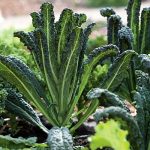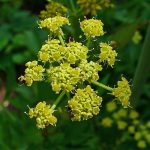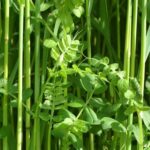Kale – Red and Green Palm
€1.95
Description
Kale – Red and Green Palm is a giant kale, easily growing to a height of 1.8m. It’s an ancient North German variety which is grown as an animal feed during the summer – you simply harvest the lower leaves and feed them to chickens, rabbits, sheep or horses and then later in the year from October throughout the winter the leaves can be used for human consumption. It just keeps on growing. This type has nearly become extinct. We planted a lot of them in the large chicken run in Kilkenny – obviously before the chickens arrived. But once the plants are 3 feet tall you could let the chickens in. In the second year the plants started to flower and we saved the seeds around July. There will be a mix of a red and green type in each packet.
These plants are definitely a show stopper in any garden. You will need good space though with a spacing of 60cm each way. I hope you enjoy them.
Sowing:
Late March to early May
Sow 1 seed per module and keep in a warm place. Pot on into 7cm pots about 4 weeks after sowing. Plant outdoors 3 to 4 weeks after potting on. Feed generously with compost or composted manure.
Spacing:
Between rows: 60cm
Between plants in the row: 60cm
Approx. seed count: 50
Growing kale:
Kale – Red and Green Palm
Latin name:
Brassica oleracea Acephala Group
Family:
Brassicaceae (also known as Cruciferae)
Related to:
Cabbage, Brussels sprouts, kohlrabi, cauliflower, radish, turnip and swede.
Botanical classification:
Brassica derives from the Celtic bresic, the name for cabbage.
Oleracea means ‘as a herb’ – the wild cabbage. Acephala means ‘without a head’.
Introduction:
Kale – Red and Green Palm is one of the hardiest winter vegetables and one of the easiest to grow. In addition, it seems to be much less plagued by all the brassica pests and diseases. I just wish we could like it more. Some varieties of kale, such as Redbor F1 and Nero di Toscana, are so attractive looking that they would deserve a prime place in your flower garden.
History:
The kale is the most similar plant to the wild ancestor of so many cultivated brassicas – Brassica oleracea – which still grows wild on the western coasts of Europe.
It was already grown in Roman times.
Soil and site:
Kale – Red and Green Palm prefers a fertile, deep soil with high moisture retention. Therefore, the soil should be free draining and also kale will tolerate poorer soils than most brassicas. The ideal pH is 6.5-7.0.
Sowing:
Not only can kale be raised in a seed bed as bare root transplants but also it can be raised in modular trays. However, if raised in modular trays it is essential that they are planted out before they become pot bound. As a matter of fact, I find that modular grown plants establish much easier. I sow one seed per cell 2cm deep.
Sow early varieties in mid April until early June.
Spacing:
Between plants: 50cm
Between rows: 50cm
Rotation:
It is absolutely essential to keep kale in the brassica section of your rotation because this will prevent a build up of the numerous brassica pests and diseases.
Plant care:
Apart from keeping the soil well hoed and weeded you should remove any discoloured lower leaves from the plant as this will improve the air-flow through the crop and therefore minimise pests (aphids) and diseases (moulds).
Harvesting and storing:
Kale is such a forgiving plant. Harvest regularly from the bottom up.
Potential problems:
Kale – Red and Green Palm is the easiest and healthiest brassica you can grow. It will suffer from all the common brassica problems but generally to a much lesser extent.
How much to grow?
If you eat kale regularly three plants are sufficient, however, if you want them for the occasional meal 1 or 2 plants will do.
For more information have a look at my monthly newsletters on:
https://greenvegetableseeds.com/newsletters/
For information on organic certification:
Have a look at the Irish Garden magazine:




